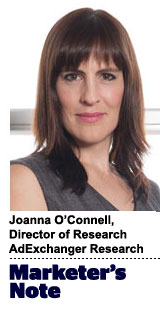 “Marketer’s Note” is a weekly column informing marketers about the rapidly evolving, digital marketing technology ecosystem. It is written by Joanna O’Connell, Director of Research, AdExchanger Research.
“Marketer’s Note” is a weekly column informing marketers about the rapidly evolving, digital marketing technology ecosystem. It is written by Joanna O’Connell, Director of Research, AdExchanger Research.
I just had a very interesting conversation with a reporter who’s trying to understand why so many publishers link “programmatic” to declines in ad revenue and/or profitability in their quarterly earnings statements. I have strong suspicions on what might be happening, but I don’t yet have a firm answer on what’s really happening, at least not yet.
Certainly, publishers will indicate that the volume of impressions they sell programmatically outstrips the revenue associated with those impressions (at least that’s what I found in my State of Programmatic Media report). But that isn’t a surprising statistic, nor is it a new phenomenon. Certainly, this was the case when publishers relied on ad networks for indirect inventory sales.
So why is programmatic seen as the culprit for declining ad dollars? My suspicion is that many, many factors are at play. Here are a few:
– Ad networks sent nice, fat checks every month, without fail. Publishers achieved consistent monthly revenue through those relationships, even if they weren’t optimized, or well understood, by some publishers. In the programmatic world, there isn’t yet a clear replacement to the networks – i.e. a single entity that consistently buys up gobs of inventory, month after month. I do anticipate, over time, this may change – with large advertisers like P&G investing mammoth sums of money in programmatic and agency trading desks increasingly striking holding company-wide deals the flow of consistent money will continue to grow.
– Media buyers were happy to buy a lot of ROS, but aren’t so much anymore. The upside for buyers of audience targeting and impression level buying – hallmarks of programmatic – is control and choice. But publishers don’t realize the same benefits, or at least in the same way. Today, programmatic can mean a lot of (sometimes unintentionally) small buys for very specific impressions – laborious to sell and manage from a human capital standpoint (certainly more, I’d imagine, than days of yesteryear where publishers could contract for giant IO’s of ROS impressions). I believe, though, as standards continue to be developed and global yield management tools continue to be developed and are adopted, the human burden of managing many, many complex programs will start to lessen, and those programs – as a whole – will add up to strong overall revenue for publishers.
– Programmatic necessitates new skills, which both publishers and buyers are still developing. We’re all still new at this, in spite of the fact that “programmatic,” in one form or another, has been around for several years. Case in point: we’d finally started to figure out exchange-based buying and selling and along came programmatic direct and all its cousins – a whole new set of programmatic transaction types was born and we’re all trying to figure out how best to make it work*. We’re still in a period of massive disruption – buyers and sellers are being asked to behave in totally new ways, and making attitudinal and behavioral transitions takes time for people. So of course things are messy and suboptimal.
BUT, these are my suspicions only, as my experiences with publishers on this subject are many but anecdotal. And I am sure this is not a complete list of culprits – just some starting thoughts. I’d like to hear from you, publishers, directly or via comments on the site – what is YOUR market reality with respect to programmatic and CPMs?
Joanna
* I think we should acknowledge that RMX had the 1:1 relationship model very early – it just happened that the two parties were often networks.
Follow Joanna O’Connell (@joannaoconnell ) and AdExchanger (@adexchanger) on Twitter.












